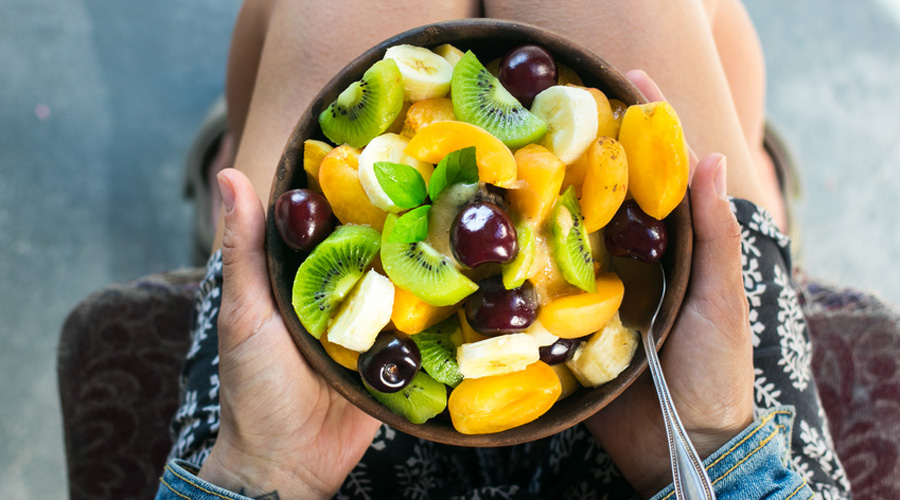However, you might not have considered eating fruits before a meal. Recently, I discovered that…

Benefits of Eating Fruits Before a Meal
1. Weight and Blood Sugar Control
Eating fruits before a meal can help reduce the intake of starchy foods, aiding in weight management and blood sugar control. Many people, especially those monitoring their weight and blood sugar, avoid fruits due to their sugar content, fearing they will spike blood sugar levels and add calories. Is this your concern?
Studies have shown that eating fruits at the right time and in moderation can benefit weight loss and blood sugar control. High blood sugar isn’t just a chronic health issue for the elderly; one-third of Europeans have elevated blood sugar levels. Keeping blood sugar stable can help manage weight and prevent some chronic diseases.
Comparative experiments revealed that people who ate an apple before a meal felt fuller and consumed significantly less energy during the meal compared to those who ate nothing beforehand. Thus, eating fruits can help control meal calorie intake.
2. Increased Satiety
Fruits are rich in dietary fiber, which increases the feeling of fullness. Eating fruits in moderation before a meal can help control calorie intake, making it a good strategy for those looking to lose weight.
3. Regulating Glycemic Response
Researchers have gone to great lengths to encourage fruit consumption. They compared the effects of eating 25 grams of carbohydrate-rich rice half an hour before a meal to replacing that rice with a kiwi containing an equivalent amount of carbohydrates. The results showed that both eating rice separately or replacing it with a kiwi reduced the glycemic response after the meal.
Adding low-glycemic index kiwi puree (equivalent to one large kiwi) to a cereal-based breakfast significantly reduced the post-meal glycemic response, promoting more stable blood sugar levels.

Choosing the Right Fruits
Although studies suggest that eating fruits before meals may help control weight and blood sugar, making wise fruit choices is crucial. Some fruits are high in sugar and fat, with calories comparable to rice. For example, seven winter jujubes have about the same calories as a bowl of rice (approximately 125 kilocalories). An avocado has about 171 kilocalories, equivalent to 1.5 bowls of rice.
Selecting fruits involves considering their calorie content, glycemic index (GI), and glycemic load (GL). This process can be complicated.

High Nutrient Density Fruits
If you want to focus on nutrition and enjoy fruits without worrying about their impact on weight and blood sugar, opt for “high nutrient density” fruits. Nutrient density indicates the amount of nutrients provided by a food relative to its calorie content. Higher nutrient density means more nutrients for the same calorie intake.
Consuming nutrient-dense fruits helps reduce the risk of cardiovascular diseases and diabetes while lowering overall mortality risk.
Fruits with high nutrient density include: Yellow-fleshed kiwis, Green-fleshed kiwis, Oranges, Strawberries, Mangoes, Lemons, Mandarins, Bananas, Grapes, Watermelons, Crown pears and Red Fuji apples
These fruits are excellent daily sources of vitamins, dietary fiber, and minerals, offering high nutritional value and health benefits.
Top Nutrient Density Fruits
In the Nutrient Adequacy Score (NAS), yellow-fleshed kiwis rank first, followed by strawberries and green-fleshed kiwis. In the Nutrient Density Score (NDS), strawberries, lemons, and yellow-fleshed kiwis occupy the top three spots. Due to the low practical consumption of lemons, green-fleshed kiwis, which rank fourth, are a better alternative.

The Power of Yellow-Fleshed Kiwis
For example, yellow-fleshed kiwis contain 171 milligrams of vitamin C per 100 grams. One yellow-fleshed kiwi provides the same amount of vitamin C as 13 citrus fruits. Eating one kiwi a day meets the daily vitamin C requirement for adults (100 milligrams), providing natural vitamin C from fresh fruits.
Yellow-fleshed kiwis also have 1.4 grams of dietary fiber per 100 grams, promoting intestinal health. With only 61 kilocalories per 100 grams and a low glycemic index of 52, they are easy to eat before meals.
We recommend consuming 200 to 350 grams of fruits daily. If you want a simple choice that ensures sufficient fruit intake, eating one kiwi before breakfast and lunch can meet your needs.
Start Eating Fruits Before Meals
Don’t wait to incorporate fruits into your diet. Begin eating fruits before meals today, especially those with high nutrient density.